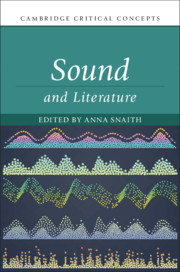Book contents
- Sound and Literature
- Cambridge Critical Concepts
- Sound and Literature
- Copyright page
- Epigraph
- Contents
- Figures
- Contributors
- Acknowledgements
- Introduction
- Part I Origins
- Chapter 1 Hearing and the Senses
- Chapter 2 Fragments on/of Voice
- Chapter 3 Sonic Forms
- Chapter 4 Classical Music and Literature
- Chapter 5 Aesthetics, Music, Noise
- Part II Development
- Part III Applications
- Bibliography
- Index
Chapter 2 - Fragments on/of Voice
from Part I - Origins
Published online by Cambridge University Press: 29 May 2020
- Sound and Literature
- Cambridge Critical Concepts
- Sound and Literature
- Copyright page
- Epigraph
- Contents
- Figures
- Contributors
- Acknowledgements
- Introduction
- Part I Origins
- Chapter 1 Hearing and the Senses
- Chapter 2 Fragments on/of Voice
- Chapter 3 Sonic Forms
- Chapter 4 Classical Music and Literature
- Chapter 5 Aesthetics, Music, Noise
- Part II Development
- Part III Applications
- Bibliography
- Index
Summary
Literature operates with voice, and voices the voices of the author/poet, of the characters (and the poem’s ‘speaker’), and of the reciter and reader. But literature also operates an extensive imaginary of voice. Voice is the ‘stuff’ of literature in two senses: its material support and an abiding theme. And criticism itself involves so many ‘voicings’ of literary texts, as we test out the texts’ possibilities, their reverberations, their potential afterlives. This chapter explores both the physiology and imaginary of voice across millennia, shaped by phenomena as various as the social function of poetry in predominantly, or exclusively, oral cultures, the class and race politics of accent, the technologies of sound recording, reproduction, transmission and processing. It approaches this history through a series of interconnecting fragments: Voice as origin to, and excess over, speech; the voices of the muses and of song, voices that come from within and without, voices that ‘possess’ us; prosthetics of voice, written or machinic; mnemonics of voice, in which voice is not just memorable but creates memory. In both its physiology and its imaginary, voice comes across as extravagant – as extravagance, even.
- Type
- Chapter
- Information
- Sound and Literature , pp. 56 - 73Publisher: Cambridge University PressPrint publication year: 2020



